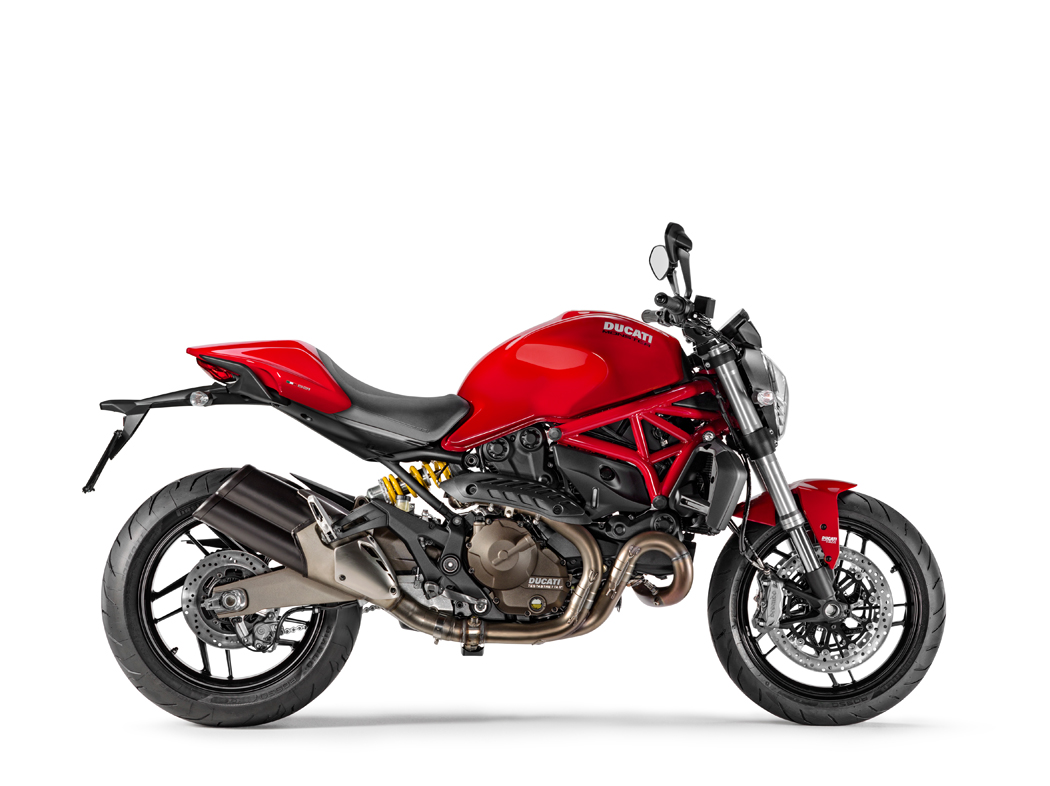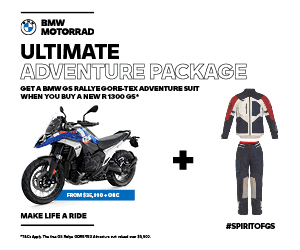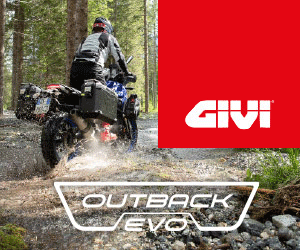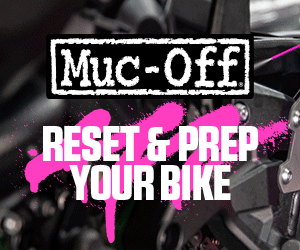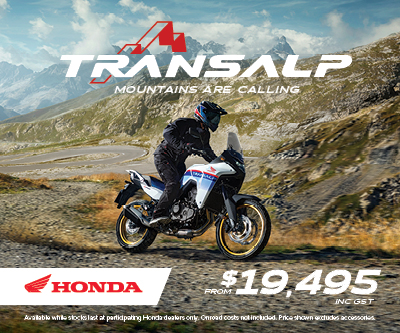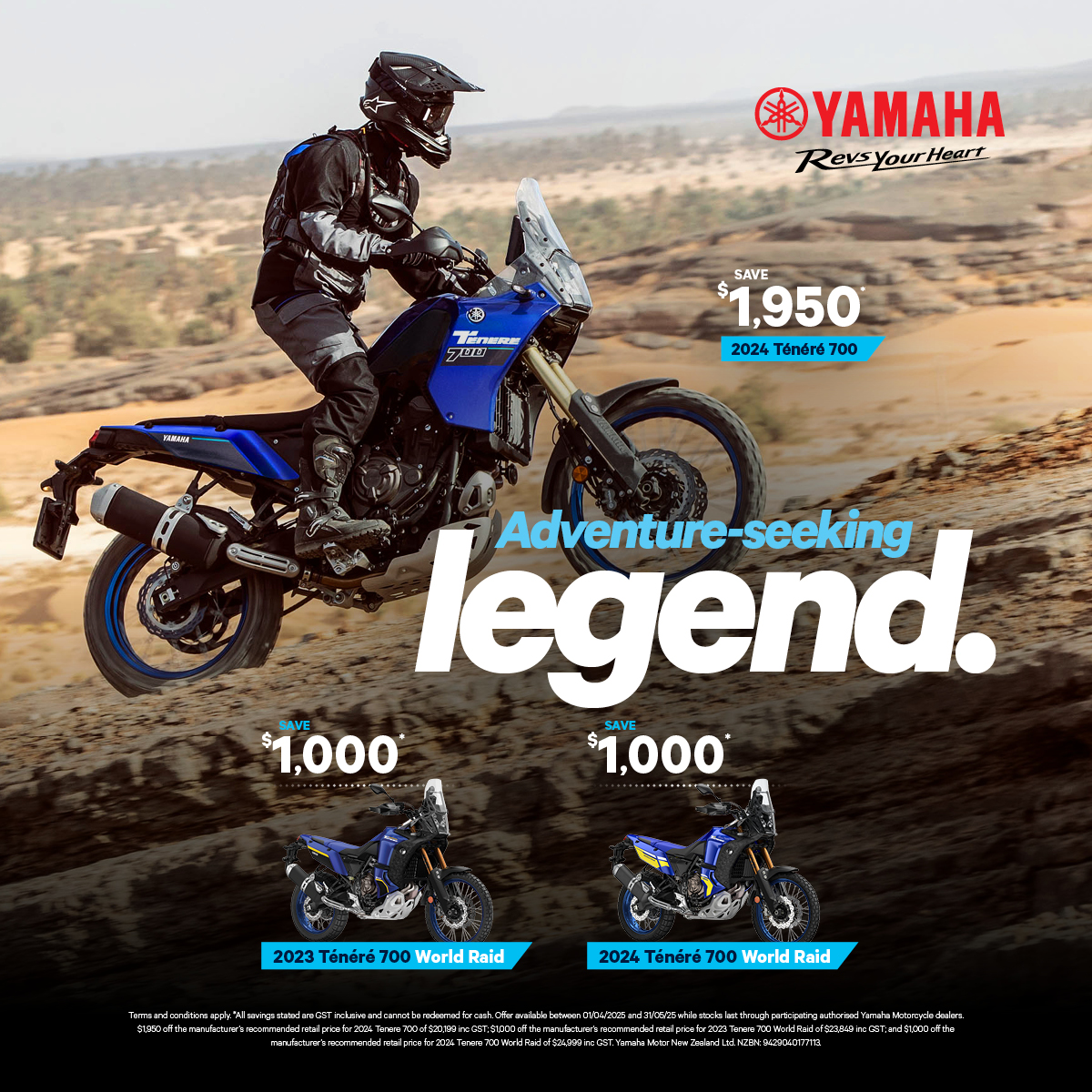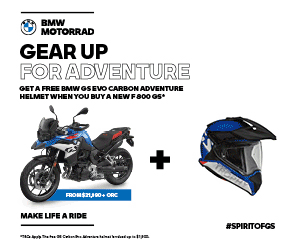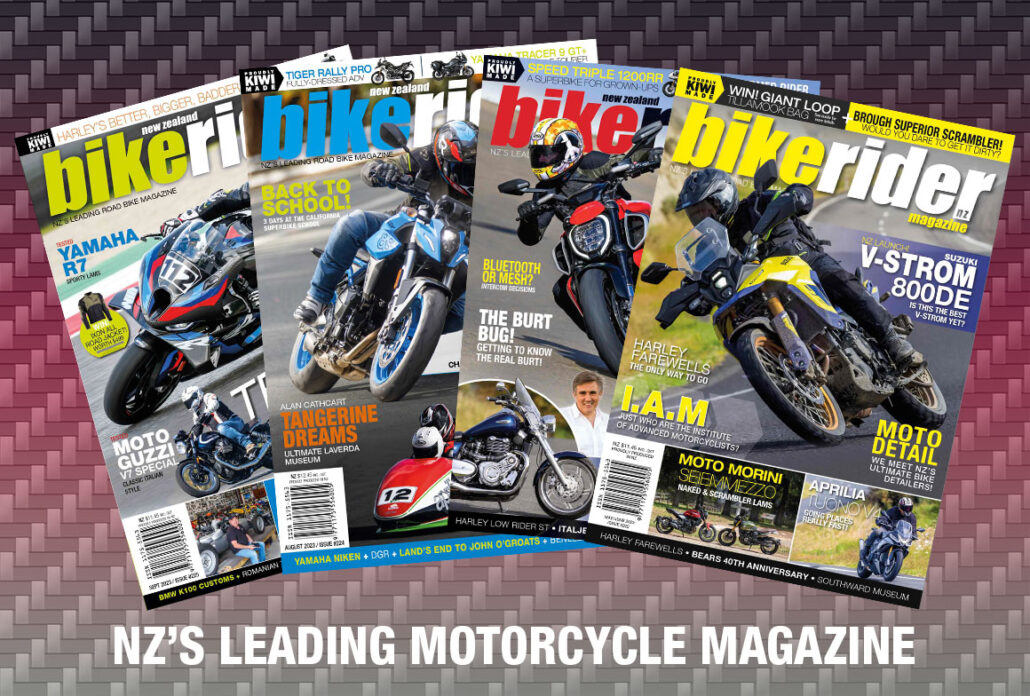Li’l Monster
Only announced in last month’s issue, Roland (insert your own favourite term here) Brown got to test the new welterweight Monster, in Ducati’s Italian back yard…Meh!
Cranking the Monster 821 through a series of tight, steep turns on the Futa pass, Ducati’s traditional testing road in the hills south of Bologna, I’m reminded of the similar launch ride on the M900 Monster that started the story back in 1993. That original model’s launch was near Cagiva’s factory in Varese, not Bologna, and the M900 was a very different bike: air-cooled, much less powerful and sophisticated.
But the sensations of riding a naked V-twin roadster with red paintwork, a capacity of about 900cc, a throaty exhaust note and a light and agile feel are much the same, and every bit as appealing as ever. That basic charm helps explain the success of the Monster; it’s why the original M900 grew into a family that has now sold well over a quarter of a million machines, and has been vital to Ducati’s health over the last two decades.
It’s an indication of how much motorcycles have advanced in that time that the M900 was regarded as a muscular big bike, yet this latest in the Monster family is a mid-ranking model despite being more than 50% more powerful. The 821 was a relatively simple project for Ducati because it’s essentially a smaller engined version of the recently released Monster 1200, powered by the 821cc eight-valve desmo unit that was introduced last year in the Hypermotard.
The liquid-cooled, DOHC Testastretta 11 degree V-twin is mechanically unchanged apart from incorporating Ducati’s APTC clutch, which gives a slipper action and a notably light feel at the lever. A larger airbox and new exhaust system with longer, equal length header pipes give a slight boost all the way through the range, to a 2bhp higher maximum of 112bhp at 9250rpm.
Chassis layout comes straight from the 1200, with no changes to the tubular steel frame, which adds rigidity and saves weight by bolting front and rear sections directly to the engine in Panigale style. There are a few differences, notably the new aluminium swingarm that is twin- instead of single-sided, and 30mm shorter than the 1200’s; partly because the less powerful bike can get away with a shorter 1480mm wheelbase.
Visually the 821 is almost identical to the bigger model, just lacking a few cosmetic touches including the belly-pan, as the smaller, less powerful motor has no need of an oil cooler. Its one-piece handlebar is made from steel instead of aluminium but the riding position is identical to the 1200’s, thanks also to an unchanged seat that is notably wider, longer and better padded than previous Monster seats, and can be adjusted to be either 785 or 810mm high.
Climbing aboard the 821 outside the launch base hotel in central Bologna revealed another difference: its digital instrument panel is a mono LCD rather than a fancy colour display like the 1200’s. But this smaller Monster gets a similar range of electronics including three riding modes, with Sport and Touring delivering the full output, the latter with softer response, and Urban softer again to a reduced 75bhp maximum.
One area where the 821 definitely doesn’t lose out is sound. The smaller V-twin fired up with a throaty bark through its shotgun pipes, burbled menacingly at idle and bellowed mightily when I blipped the throttle, sounding if anything slightly louder and sharper than the 1200. There’s a valve somewhere in the system, and Ducati’s development team have worked wonders to get such a glorious sounding bike through modern emissions tests.
They’ve also done a good job with the fuelling, which was predictably sweet, the ride-by-wire throttle action making the Monster very rider-friendly in traffic. In Bologna I generally left it in Urban mode, which as normal with a Ducati also fine-tunes the eight-level traction control system and the ABS brake level, both of which can also be adjusted or turned off manually.
Pressing the indicator button to select Touring mode summoned the full complement of horsepower, with a very smooth power delivery that was welcome when we reached the first series of bends at the same time as the rain. One rider complained of hesitation in the throttle response but I didn’t notice that. Nor did I have a problem with the gearshift, which was very sweet. But another rider struggled to find neutral, as I did on the Diavel on that bike’s launch, suggesting Ducati’s quality control in that respect is variable.
One thing that remained consistent was the Monster motor’s impressive amount of grunt throughout the range, especially for a so-called middleweight. The 821cc motor has fairly long-stroke dimensions (at 88 x 67.5mm, its bore is 8mm narrower than the 1200’s but stroke is just 0.4mm shorter) and is impressively flexible. Compared to the Monster 796’s air-cooled, 803cc engine its torque curve is almost identical from 6-6500rpm but considerably higher both below and above that range.
That helped make the Ducati very easy to ride even on slightly damp, slippery looking roads in the photo session, where it was responsive yet reassuringly docile and controllable. And respectably quick, too. When the roads dried, switching to Sport mode sharpened the throttle response and had the Monster leaping forward enthusiastically, its tacho bar jabbing towards the 11,000rpm limit through the gears.
Enthusiastic But Friendly
There’s enough top-end power for some serious speed, too, even if the 821 can’t approach the bar-bending acceleration of the Monster 1200, let alone the most powerful super-nakeds. When we turned off the Futa and headed down a faster main road towards the lunch stop near Vergaro, it sat smoothly at 140km/h and stormed briefly to 185km/h, heading for a top speed of about 220km/h while I gripped the raised bar — which is slightly higher and further back than the Monster 796’s — increasingly tightly.
By then we’d ridden round many dozens of bends on the Futa in both wet and dry; enough to confirm that the Pirelli Diablo Rosso II tyres grip reliably what ever the conditions, and that the Monster 821 has plenty of ground clearance and is even more flickable than the 1200. As well as that shorter wheelbase it’s a few kilos lighter, at 205.5kg wet, and has a narrower, 5.50in rear wheel shod with a 180- instead of 190-section rear tyre.
Its suspension did a pretty good job, too, although the set-up is fairly basic, with non-adjustable 43mm upside-down Sachs forks, plus a diagonally mounted shock from the same firm that is operated directly by the swing-arm, has a dual-rate spring and is adjustable for preload and rebound damping.
Ride quality was pretty good, the suspension giving a taut, reasonably firm feel while also soaking up bumps with notably more efficiency than I recall from Monsters of a few years ago. Once the roads dried out completely, hard riding occasionally had the Ducati moving around slightly in bumpier bends, but it always felt respectably precise and controllable.
It had plenty of stopping power, too, thanks to a Brembo blend of 320mm front discs and radial Monobloc calipers that is the same as that of the standard Monster 1200, apart from not having a radial master cylinder; and which supplied similar power and feel. On slippery roads I was glad of the typically excellent Bosch ABS system, which required a firm squeeze before it made itself felt. The rear disc was typically lacking in feel but at least with ABS there was no worry about overdoing it.
The Monster 821’s electronic features are arguably the biggest difference between this bike and previous models, and mostly in a good way. The traction control system is a bit tricky to turn off if you want to pull a wheelie, but like the ABS it was especially welcome in the wet. The instrument panel is less eye-catching than the 1200’s but still shows fuel consumption and range to empty, incorporates a lap timer and shift light, and is adjustable for brightness.
More importantly, though, Ducati have got the Monster basics sorted these days. Its riding position is roomy; controls work smoothly; even the mirrors are useful. The 17.5-litre tank should be good for 250km at a typical 6-7l/100km average. The seat was respectably comfortable, and removing its colour-matched pillion seat cover (standard fitment, except with the matt black Dark model) reveals a reasonably, if not generously, sized pillion seat with sturdy grab-handles alongside.
The Monster 821 is certainly a much more sophisticated bike than its ancestor the M900, while managing to match the old air-cooled model’s raw V-twin character and sound. In many respects it echoes the 899 Panigale in offering most of the performance and entertainment value of a larger model, along with a more rider-friendly character and price. That said, it’s not particularly cheap, being closer in price to the 1200 than to the entry-level Monster 696 in most markets.
But being priced fairly high by naked bike standards didn’t prevent the M900 Monster from being a spectacular sales success, and this latest model looks like repeating the trick. It’s good looking, quick, agile, refined, easy to ride and respectably versatile and comfortable. Despite its middleweight status it’s very much a grown-up Monster — and arguably the best, most complete bike yet from this most famous of motorcycling families.
Giuglio Malagoli, Monster 821 Project Engineer
“We think the 821 is the perfect first bike for all Monsteristi, and also riders of the current 1100 will love it because it is agile, very easy to ride, but also has all the power that you need.
“The maximum horsepower is more or less the same as we had in the past with the Monster S4, a real muscular, naked, aggressive strong bike for experienced riders. And now we have this performance on a bike that is very easy to ride. This is due to the electronics and the technology, which get better and better.
“Our target was to have the same feeling as the original Monster. The 821 had to be agile for the Futa because this is the perfect road for the Monster, but also for the city because a lot of Monster riders use their bike there. They go to the pub in the evening or to the office in the morning, and at the weekend they ride the roads in the hills.
“The exhaust is quite loud but it’s fully homologated, obviously. The decibels are the same as the 1200 but the 821 is different because its tone is quite aggressive. Making the bike sound good was one of our targets because we think that the voice of the engine is part of the fun.”
Specs
Price: TBA
Engine type Liquid-cooled 90-degree V-twin
Valve arrangement DOHC, desmodromic eight valves
Displacement 821cc
Bore x stroke 88 x 67.5mm
Compression ratio 12.8:1
Carburation Continental injection system, Mikuni throttle bodies
Maximum power 112bhp @ 9250rpm
Maximum torque 89.4N.m @ 7750rpm
Clutch APTC wet multiplate slipper
Transmission 6-speed
Front suspension 43mm inverted telescopic Sachs, 130mm travel
Rear suspension One Sachs damper, 140mm wheel travel, adjustments for preload and rebound damping
Front brake 2, four-piston Brembo radial Monobloc calipers, 320mm discs with ABS
Rear brake Twin-piston Brembo caliper, 245mm disc with ABS
Front wheel 3.50 x 17in; cast aluminium
Rear wheel 5.50 x 17in; cast aluminium
Front tyre 120/70 x 17in Pirelli Diablo Rosso II
Rear tyre 180/60 x 17in Pirelli Diablo Rosso II
Rake/trail 24.3 degrees/93.2mm
Wheelbase 1480mm
Seat height 785-810mm
Fuel capacity 17.5 litres
Weight 205.5kg wet (tank 90 per cent full); 179.5kg dry

